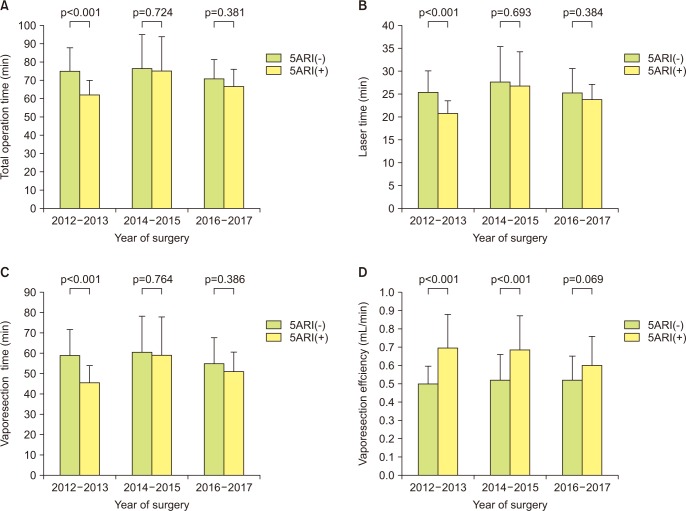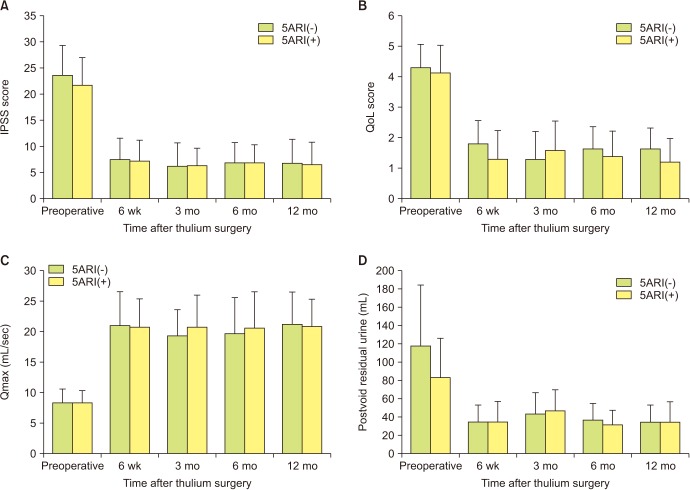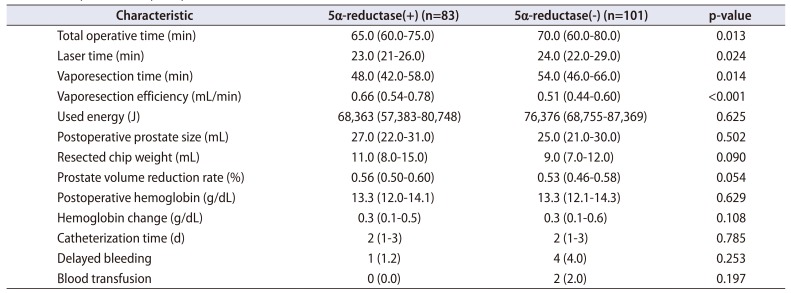1. Cornu JN, Ahyai S, Bachmann A, de la Rosette J, Gilling P, Gratzke C, et al. A systematic review and meta-analysis of functional outcomes and complications following transurethral procedures for lower urinary tract symptoms resulting from benign prostatic obstruction: an update. Eur Urol. 2015; 67:1066–1096. PMID:
24972732.

2. Gravas S, Bachmann A, Reich O, Roehrborn CG, Gilling PJ, De La Rosette J. Critical review of lasers in benign prostatic hyperplasia (BPH). BJU Int. 2011; 107:1030–1043. PMID:
21438974.

3. Xia SJ, Zhuo J, Sun XW, Han BM, Shao Y, Zhang YN. Thulium laser versus standard transurethral resection of the prostate: a randomized prospective trial. Eur Urol. 2008; 53:382–389. PMID:
17566639.

4. Gross AJ, Netsch C, Knipper S, Hölzel J, Bach T. Complications and early postoperative outcome in 1080 patients after thulium vapoenucleation of the prostate: results at a single institution. Eur Urol. 2013; 63:859–867. PMID:
23245687.

5. Kim HK, Zhao C, Choi BR, Chae HJ, Kim DS, Park JK. Is transforming growth factor-β signaling activated in human hypertrophied prostate treated by 5-alpha reductase inhibitor? Dis Markers. 2013; 35:679–685. PMID:
24311892.
6. Hochberg DA, Basillote JB, Armenakas NA, Vasovic L, Shevchuk M, Pareek G, et al. Decreased suburethral prostatic microvessel density in finasteride treated prostates: a possible mechanism for reduced bleeding in benign prostatic hyperplasia. J Urol. 2002; 167:1731–1733. PMID:
11912398.

7. Sato R, Sadaoka Y, Nishio K, Kobori Y, Yagi H, Arai G, et al. Effects of preoperative dutasteride treatment in holmium laser enucleation of the prostate. Int J Urol. 2015; 22:385–388. PMID:
25631165.

8. Donohue JF, Sharma H, Abraham R, Natalwala S, Thomas DR, Foster MC. Transurethral prostate resection and bleeding: a randomized, placebo controlled trial of role of finasteride for decreasing operative blood loss. J Urol. 2002; 168:2024–2026. PMID:
12394700.

9. Hahn RG, Fagerström T, Tammela TL, Van Vierssen Trip O, Beisland HO, Duggan A, et al. Blood loss and postoperative complications associated with transurethral resection of the prostate after pretreatment with dutasteride. BJU Int. 2007; 99:587–594. PMID:
17407516.

10. Kravchick S, Cytron S, Mamonov A, Peled R, Linov L. Effect of short-term dutasteride therapy on prostate vascularity in patients with benign prostatic hyperplasia: a pilot study. Urology. 2009; 73:1274–1278. PMID:
19375786.

11. Pastore AL, Mariani S, Barrese F, Palleschi G, Valentini AM, Pacini L, et al. Transurethral resection of prostate and the role of pharmacological treatment with dutasteride in decreasing surgical blood loss. J Endourol. 2013; 27:68–70. PMID:
23030716.

12. Araki M, Lam PN, Culkin DJ, Wong C. Decreased efficiency of potassium-titanyl-phosphate laser photoselective vaporization prostatectomy with long-term 5 alpha-reductase inhibition therapy: is it true? Urology. 2007; 70:927–930. PMID:
18068449.

13. Bepple JL, Barone BB, Eure G. The effect of dutasteride on the efficacy of photoselective vaporization of the prostate: results of a randomized, placebo-controlled, double-blind study (DOP trial). Urology. 2009; 74:1101–1104. PMID:
19800668.

14. Strom KH, Gu X, Spaliviero M, Wong C. The effects of 5α-reductase inhibition on benign prostatic hyperplasia treated by photoselective vaporization prostatectomy with the 120 Watt GreenLight HPS laser system. J Am Coll Surg. 2011; 212:244–250. PMID:
21183365.

15. Warner JN, Nunez RN, Tyson MD, Viprakasit DP, Miller NL, Humphreys MR. A multiinstitutional study of the effects of medical therapy for lower urinary symptoms on the perioperative outcomes of holmium laser enucleation of the prostate. Urology. 2011; 78:1385–1390. PMID:
21871654.

16. Monn MF, El Tayeb M, Bhojani N, Mellon MJ, Sloan JC, Boris RS, et al. Predictors of enucleation and morcellation time during holmium laser enucleation of the prostate. Urology. 2015; 86:338–342. PMID:
26189134.

17. Dimopoulos P, Christopoulos P, Kampantais S. A focused review on the effects of preoperative 5α-reductase inhibitors treatment in patients undergoing holmium laser enucleation of the prostate: what do we know so far? J Endourol. 2018; 32:79–83. PMID:
29161905.

18. Herrmann TR, Bach T, Imkamp F, Georgiou A, Burchardt M, Oelke M, et al. Thulium laser enucleation of the prostate (ThuLEP): transurethral anatomical prostatectomy with laser support. Introduction of a novel technique for the treatment of benign prostatic obstruction. World J Urol. 2010; 28:45–51. PMID:
20063164.

19. Bach T, Xia SJ, Yang Y, Mattioli S, Watson GM, Gross AJ, et al. Thulium: YAG 2 mum cw laser prostatectomy: where do we stand? World J Urol. 2010; 28:163–168. PMID:
20204378.
20. Sandfeldt L, Bailey DM, Hahn RG. Blood loss during transurethral resection of the prostate after 3 months of treatment with finasteride. Urology. 2001; 58:972–976. PMID:
11744471.

21. McConnell JD, Roehrborn CG, Bautista OM, Andriole GL Jr, Dixon CM, Kusek JW, et al. Medical Therapy of Prostatic Symptoms (MTOPS). The long-term effect of doxazosin, finasteride, and combination therapy on the clinical progression of benign prostatic hyperplasia. N Engl J Med. 2003; 349:2387–2398. PMID:
14681504.

22. Kearney MC, Bingham J, Bergland R, Meade-D'Alisera P, Puchner PJ. Clinical predictors in the use of finasteride for control of gross hematuria due to benign prostatic hyperplasia. J Urol. 2002; 167:2489–2491. PMID:
11992064.

23. Pareek G, Shevchuk M, Armenakas NA, Vasovic L, Hochberg DA, Basillote JB, et al. The effect of finasteride on the expression of vascular endothelial growth factor and microvessel density: a possible mechanism for decreased prostatic bleeding in treated patients. J Urol. 2003; 169:20–23. PMID:
12478093.

24. Sutton MT, Yingling M, Vyas A, Atiemo H, Borkowski A, Jacobs SC, et al. Finasteride targets prostate vascularity by inducing apoptosis and inhibiting cell adhesion of benign and malignant prostate cells. Prostate. 2006; 66:1194–1202. PMID:
16652387.

25. Iczkowski KA, Qiu J, Qian J, Somerville MC, Rittmaster RS, Andriole GL, et al. The dual 5-alpha-reductase inhibitor dutasteride induces atrophic changes and decreases relative cancer volume in human prostate. Urology. 2005; 65:76–82. PMID:
15667867.

26. Donohue JF, Hayne D, Karnik U, Thomas DR, Foster MC. Randomized, placebo-controlled trial showing that finasteride reduces prostatic vascularity rapidly within 2 weeks. BJU Int. 2005; 96:1319–1322. PMID:
16287453.









 PDF
PDF ePub
ePub Citation
Citation Print
Print




 XML Download
XML Download